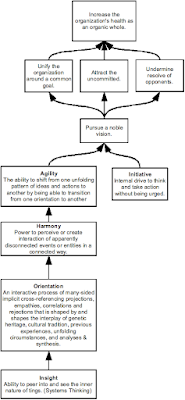One More OODA Loop Through the IOHAI Hoop

In a previous article I wrote about IOHAI - John Boyd's leadership model. I used Intermediate Objective maps to deconstruct IOHAI in a manner consistent with the ideas in Boyd's essay Destruction & Creation. A friend told me it was the most incomprehensible essay I had ever written. I regard that as a challenge to make one more OODA loop through the IOHAI hoop. (Though I should warn you I write to comprehend, not to be comprehended.) In the previous article I mentioned there was another way to decontruct IOHAI. Actually, there is an infinity of ways. Here is one, created under the assumption that Orientation means "good Orientation". Under that assumption, Insight becomes a prerequisite for Orientation. I have also made Orientation a prerequisite for Harmony. We cannot achieve Harmony if we are no good at Orienting ourselves: Now let's look at Initiative, hanging there all by itself. Initiative is a personal property. Some people have more, others have less. I...

